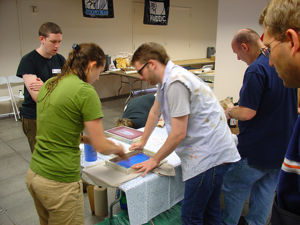Practical assessment
Contents
Practical Assessment
In this module, some tools used to assess students' practical skills are explored. The expectations and implications of marking practical skills in a variety of contexts such as workshops, clinical placements or industry settings are also investigated.
Assessing Practice
This involves both practical skills and practical experience.
Practical experience encompasses the skills but is much broader to include all the factors that make up the contextual complexity of a work environment.
Collectively a workshop group explored different forms of practical assessment they had used:
- Restaurant and café practice (real work experience)
- Role plays (simulated work experience)
- Clinic for counselling students
- Placements with agencies
- Project based
- Electronic scenario based exercises
- Presentations
- Portfolio and case study of clinical/work experience
- Product - sample
- Clinical experience
- Facilitate and take part in group work
- Studio projects (teams of 3)
- OSCE (objective structured clinical examination)
- Video assessment
The group then undertook an exercise to create an origami paper cup. Once the product was complete they explored what criteria they would use to assess this skill
| Try the exercise.
Make a paper cup using the linked instructions. Compare your criteria with that of the group.
|
Origami skill assessment criteria from workshop group.
This is a collation of all criteria. Smaller groups within the larger group focused on different criteria.
- Fit for purpose - (potential that no other criteria necessary)
- Had to hold water without leaking
- Had to have symmetry
- Health and safety – corners not too sharp
- Speed
- Quality
- Precision of folds
- Everything lined up
- Overall presentation
- No holes
- No gaps
This exercise showed that the criteria can vary dependent upon what exactly you were looking for.
It also led to a revisit of the discussion on:
Norm based referencing – compare against others
Criterion based referencing – compare against set criteria
Norm referenced assessment
core definition
Norm-referenced assessment is the process of evaluating (and grading) the learning of students by judging (and ranking) them against the performance of their peers.
explanatory context
Norm-referenced assessment is contrasted with criteria-referenced assessment. The former tends to be relative to performance of others while the latter is based on performance against pre-set criteria.
Criteria-referenced assessment
Criteria-referenced assessment: Criteria-referenced assessment is the process of evaluating (and grading) the learning of students against a set of pre-specified criteria.
Assessing Practical Skills
Consider the following questions by Phil Race (1999).
Jot down or record your answers to the following questions:
|
What exactly are the practical skills we wish to assess?
- a vast range of skills from deftness in assembly to speed and precision
Why do we need to assess practical skills?
- "credibility of our courses often depends on what students can do when they enter employment".(Race, 1999, p 139)
Where is the best place to try and measure these skills?
- Depends upon the context - may be laboratories or workshops; it may require real-life working situations.
When is the best time to measure practical skills?
- Starting early in a course is preferable to allow for correction and improvement.
Who is in the best position to measure practical skills?
- For many skills valid assessment requires detailed observation usually by a staff member, can be time consuming and threatening for students.
Is it necessary to establish minimum acceptable standards?
- Again dependent upon context - a high level of skill is essential in areas such as surgery where as in other situations a reasonable level of skill may be acceptable
How much should practice skills count for?
- Students often spend considerable time practicing skills, they need to be informed of how much is time required in relation to their overall assessment for each course.
- (Race, 1999)
Assessing Experience
Be clear about the purpose of the assessment
Why you are assessing and what you want the evidence to demonstrate?
Who is the best person to do the assessment?
Employers, professional supervisors, colleagues, mentors, tutor assess on workplace visit?
Consider carefully the implications of who is doing the assessing and their skill and ability to do the assessment.
Get the balance right
How is the experience to be marked and what percentage of the overall grade for the course will this represent?
Expect placements to be very different
Therefore be very careful about the criteria you are using to assess the experience to ensure validity and reliability.
Evidence
Types of evidence that can be used are wide and varied.
|
Jot down as many forms of evidence that you can think of, that will provide useful tools to assess experience.
Evidence may include:
|
Is there anything that you could consider using that you are not currently using?
References
- Brown, S. & Glasner, A. (Eds.). (1999). Assessment matters in higher education: Choosing and using diverse approaches. London: The Society for Research into Higher Education and Open University Press.
- Harvey, L., 2004–9, Analytic Quality Glossary, Quality Research International. Retrieved on 29 October 2009 from http://www.qualityresearchinternational.com/glossary/
- Race, P. (Ed.).(1999). The Times Higher Education Supplement: 2000 tips for
lecturers. London: Kogan Page.
Additional Resources
For further reading on norm and criteria based assessment try:
For further reading on assessing practical skills
Also check out the library databases for journal articles focused on your vocational area.

